OUR CROPS

Potato can grow in almost any climate, from sea level to 4,000 meters above sea level.

When boiled, a medium-sized potato contains about half the daily adult requirement of vitamin C and significant amounts of vitamin B, iron, potassium, and zinc.

More than a billion people worldwide eat potato as a staple food.

Grown in about 130 countries, potato is the third most important food crop after rice and wheat, and it produces more calories per hectare than either of those grains.

China is the world’s largest producer, harvesting more than 73 million tons of potato a year.

Potato produces more food per unit of water than any other major crop.
SWEETPOTATO

Just 125 g of fresh orange-fleshed sweetpotato root contains enough beta carotene to provide the daily vitamin A needs of a preschool-aged child. The crop is also a valuable source of vitamins B, C, and E.

More than 105 million tons are produced globally each year, with 95% in developing countries.

Sweetpotato is also a healthy, cheap animal feed. Studies suggest that livestock fed on sweetpotato vines produce less methane, meaning its use could potentially mitigate global warming.

Sweetpotato produces more calories per unit of time and per hectare than grain crops and many varieties are ready for harvest within 3 to 4 months of planting.

Worldwide, sweetpotato is the sixth most important food crop after rice, wheat, potatoes, maize, and cassava, but it ranks fifth in developing countries.

Sweetpotato can grow at altitudes from sea level to 2,500 meters above sea level, and comes in varieties ranging in color from white to yellow to orange to purple.

